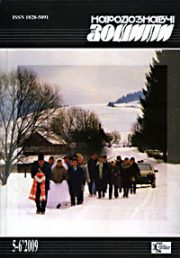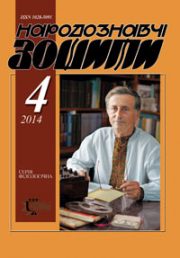The Ethnology Notebooks. 2019, № 4 (148), 951—1000
УДК 398.332
DOI https://doi.org/10.15407/nz2019.04.951
POPULAR CALENDAR OF BEREZNIVSHCHYNA IN RITUALS, CUSTOMS AND FOLKLORE
HALAICHUK Volodymyr
ORCID ID: https://orcid.org/0000-0001-7780-5876
Candidate of Philology, docent
The Ivan Franko National University of Lviv
Department of Ethnology
1, Universytets’ka str., 79000, L’viv, Ukraine
Contacts: е-mail: halay_czuk@ukr.net
Abstract. The elucidation of the local specificity of certain ethnographic regions nowadays is one of the most important and relevant trends in the study of the traditional culture of Ukrainians.The author sets the goal in the research, to comprehensively describe the national calendar of Bereznivshchyna, which is part of the Western Polissya. The object of the research is the calendar-marked rites, customs, beliefs and folklore of the inhabitants of Bereznivshchyna, and the subject is their general-Ukrainian features, regional and local peculiarities. The methodological basis of the research is the use of basic methods of ethnological science, primarily the method of field ethnography, as well as the development of ethnographers in the field of formation of folk calendars in local areas. The traditional calendar of Bereznivshchyna has not been the subject of special studies yet. This aspect is elucidated in the scientific literature quite sparingly, so the basis of the work is the author’s field materials.
This article describes in detail the register of holidays and dedications, which is important folk component of Bereznivshchyna.
Ritual games with «Kalyta» on Andri’s day, the custom «go to the Gypsies» on Varvara,
«calling the Frost» usually on the Rich kutya attracts attention to the holidays of the folk winter calendar.
The spring period is detemined by the custom of «Kolodka», timed to the Masnycy, with local representations that Marco Klyuchnik in the spring «disposes of the land». Attracted attention is also to the archaic customs of dancing on the cemetery on the Provod, walking «rocking in the rye» on Yuri, as well as a ritualized grazing of the cattle on the grass timed to Yuri.
Among the holidays of the summer complex, the Rusal Week is first of all distinguished. As is typical of the Polissian tradition, a number of rituals, customs and superstitions this week are associated with the notions of mermaids. The peculiarities of local Kupala customs and rituals, accompanied by the production of plant substitute witches, are noted. The local tradition is «to strangle the cuckoo». The variety of rituals with the so-called «beard» attracts attention among harvivarian traditions .
The local peculiarity of autumn holidays is characterized by ideas related to the days of «Miracle» and Exaltation. An important place among the customs and ordinances of the autumn occupy those that are aimed at honoring the ancestors.
It should also be noted that, according to the author’s observation, the southern margins of Bereznivshchyna in some aspects tend to gravitate towards the Volyn ethnographic tradition.
Keywords: Polissya, Bereznivshchyna, calendar customs and ceremonies, Christmas, Easter, Yuri’s day, mermaids week, Kupala.
Received 10.05.2019
REFERENCES
Kovalchuk, V. (Ed.), & Hapon, L. (2001). Kupala and Petrovich songs. In Ethnocultural heritage of Rivne Polissya: materials of complex scientific expeditions of the Rivne Folklore and Ethnographic Society (Issue I, pp. 76—91). Rivne: Volyn’s Amulets [in Ukrainian].
Kovalchuk, V., Parkhomenko, T., Ukrainets, A. (3 eds.), & Hapon. L. (2002). Vesnyanki. In Ethnocultural heritage of Rivne Polissya (Issue II, pp. 58—64). Rivne: Perspective [in Ukrainian].
Kovalchuk, V. (2003). Songs from Vitkovychi village of Bereznivsky district. In Ethnocultural heritage of Rivne Polissya (Issue IV, pp. 234—241). Rivne: Perspective [in Ukrainian].
Kovalchuk, V. (Ed.), Hapon, L. (2005). Christmas carols «koliady» and «shchedrivky». Bilka of Bereznivskyi rayon (according to the expedition 1999). In Ethnocultural heritage of Polissya (Issue VІ, pp. 80—92). Rivne: Perspective [in Ukrainian].
Kovalchuk, N.A. (2008). Calendary customs and ordinances of Rivne Polissya: local specificity and transformations (XX — the beginning of the XXI century.): author’s abstract. Dis … Cand. is Sciences: 07.00.05; National Academy of Sciences of Ukraine, Institute of Art History, Folklore Studies and Ethnology. M.T. Rylsky. Kyiv [in Ukrainian].
Parkhomenko, T.P. (2008). Calendar customs and ordinances of the Rivne region: materials of the field research. Rivne: publisher Oleg Zen [in Ukrainian].
Fedas, T.O. (2011). Folklore and ethnographic complex of Mikhail village of Bereznivsky district of Rivne region (scientific work). berezne.libr.rv.ua/kr/91.pdf [in Ukrainian].
Rybak, Y. (2016). Folk songs of Bereznivshchyna: on the materials of the expedition of 2013. Rivne: M. Dyatlik [in Ukrainian].
Kovalchuk, V. (Ed.), & Hapon, L., Boyarska, N. Christmas carols and family gatherings in the village of Bilka, Bereznivsky district. In Chronicle of Bereznivshchyna: scientific notes of Bereznivsky Local Historical Museum (Issue 1, pp. 165—177). Rivne: O. Zen [in Ukrainian].
Parkhomenko, T. (Ed.), & Hapon, L., Boyarska, N. (2011). Calendar-ritual songs of Bereznivshchyna. In Chronicle of Bereznivshchyna: scientific notes of Bereznivsky Local Historical Museum (Issue 1, pp. 178—199). Rivne: O. Zen [in Ukrainian].
Khimina, V. (2015). Calendar-ritual songs of the village of Bilka, Bereznivsky district. Valentine’s Khimina records. Transcriptions of Volodymyr Kozak. In Chronicle of Bereznivshchyna: scientific notes of Bereznivsky Local History Museum (Issue 2, pp. 173—190). Rivne: O. Zen [in Ukrainian].
Guntik, T. (2017). Calendar and ritual songs of the Northern Bereznivshchyna in the system of Polissya folklore. In Chronicle of Bereznivshchyna: scientific notes of Bereznivsky Regional Museum of Local Lore (Issue 3, pp. 133—149). Rivne: O. Zen [in Ukrainian].
Starynska, T. (2011). Treasures of Prince-village. In Chronicle of Bereznivshchyna: scientific notes of Bereznivsky Local History Museum (Issue 1, pp. 148—164). Rivne: O. Zen [in Ukrainian].
Vasyanovich, O. (2015). Water in the Meteorological Beliefs of the Polishchuk in Bereznivshchyna. In Chronicle of Bereznivshchyna: scientific notes of Bereznivsky Local Historical Museum (Issue 2, pp. 139—143). Rivne: O. Zen [in Ukrainian].





